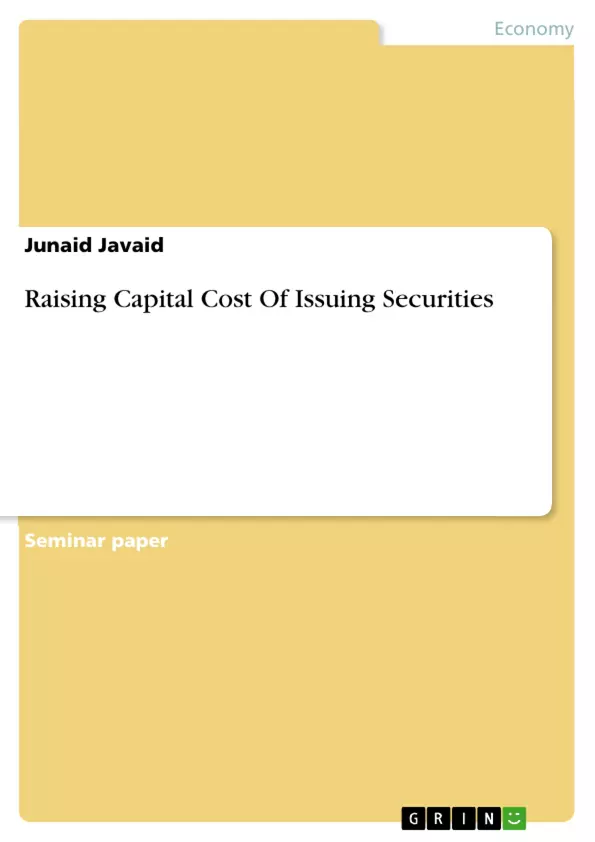The central focus of this research project is to guide the relatively medium sized car dealership company towards making decision on the appropriate security financing option so that it would permit the given company to expand its operation while minimises its cost and maximises its profitability. In general there are three types of security financing (Equity Securities, Debt Securities and Asset-Backed Securities). Security Financing is also considers being a good financing source which involves the issuance of securities either in the stock market or in the capital market. In general, the companies’ financial decision subject to the composition of its Capital Structure. The Capital Structure is made up of two factors: debt & equity. The trade-off theory was originated out of debate over the Modigiliani Miller theorem. The term trade-off theories was been used by different authors to state different group or similar related theories. The static trade-off theory confirms that the firm has perfect capital structure which they gain by trading off cost from the benefits of the use of equity and debt. The dynamic trade-off theory relates to the role of profit, role of retained earnings and path dependence. The concept of agency theory is emphasised more on the approach of concentrating on the nature of relationship existing between the company’s shareholders (Principal) and their managers (Agents). Pecking order theory stressed that the company should first prefer to use internally generated income for the purpose of raising as it would restrict the company to expose itself towards financial leverage. The marketing timing theory state that firm value their equity in the way that when the stock price is perceived to be overvalued then they issue new stock and gain their share back. After the careful analysis of all possible options, it seemed better for the medium sized Car Dealership Company to go for option of debt security instrument known as Debentures for the purpose of pursuing expansion.
Inhaltsverzeichnis (Table of Contents)
- Section-1: Aims & Objectives
- 1.1. Background Context
- 1.2. Problem Statement
- 1.3. Research Aim
- 1.4. Research Objective
- 1.5. Summary
- Section-2: Literature Review
- 2.1. Capital Structure
- 2.1.1. Trade-off Theory
- 2.1.2. Static Trade-off Theory
- 2.1.3. The dynamic Trade-off theory
- 2.1.4. Agency Theory
- 2.1.5. The Pecking Order Theory
- 2.1.6. The Marketing timing theory
- 2.1.7. Modigliani-Miller Theory
- 2.2. Equity Securities
- 2.2.1. Ordinary Shares
- a) Advantages
- b) Disadvantages
- 2.2.2. Preference Shares
- a) Advantages
- b) Disadvantages
- 2.2.1. Ordinary Shares
- 2.3. Debt Securities
- 2.3.1. Debentures
- a) Advantages
- b) Disadvantages
- 2.3.1. Debentures
- 2.4. Asset-Backed Securities (ABS)
- 2.4.1. Securitisation
- a) Advantages
- b) Disadvantages
- 2.4.1. Securitisation
- 2.5. Summary
- 2.1. Capital Structure
- Section-3: Case Studies, Analysis & Discussion
- 3.1. Case Studies
- 3.1.1. Case Study on Equity Security
- 3.1.1.1. Company Profile
- 3.1.1.2. Raising of Capital from Ordinary Shares
- 3.1.1.3. Findings
- 3.1.2. Case Study on Debt Security
- 3.1.2.1. Company Profile
- 3.1.2.2. Raising of Capital from Ordinary Debentures
- 3.1.2.3. Findings
- 3.1.3. Case Study on Asset-Backed Securities (ABS)
- 3.1.3.1. Company Profile
- 3.1.3.2. Raising of Capital from Securitisation
- 3.1.3.3. Findings
- 3.1.1. Case Study on Equity Security
- 3.2. Analysis
- 3.3. Discussion
- 3.4. Summary
- 3.1. Case Studies
Zielsetzung und Themenschwerpunkte (Objectives and Key Themes)
The main objective of this research project is to provide guidance to a medium-sized car dealership company on the most appropriate security financing option for expansion. This involves identifying the best strategy to minimize costs and maximize profitability. The project explores various security financing options like equity securities, debt securities, and asset-backed securities.
- Capital Structure: The research examines different theories related to capital structure, including trade-off, agency, pecking order, and market timing theories.
- Equity Securities: The report focuses on the characteristics, advantages, and disadvantages of ordinary and preference shares as financing instruments.
- Debt Securities: The research explores the role of debentures in capital raising, analyzing their advantages and disadvantages.
- Asset-Backed Securities (ABS): The project analyzes the process of securitization, discussing its benefits and drawbacks as a financing option.
- Company Expansion: The report delves into how companies can leverage different security financing options to achieve successful expansion while considering cost and profitability.
Zusammenfassung der Kapitel (Chapter Summaries)
Section 1: Aims & Objectives
This section establishes the context and problem statement of the research. It outlines the company's need for expansion and explores the various aspects that need to be considered when choosing a security financing option, including the amount of capital required, the desired time period, and the type of security.
Section 2: Literature Review
This section provides a comprehensive review of relevant theories and concepts related to capital structure and security financing. It examines classic theories like the Modigliani-Miller theorem and various trade-off theories, as well as more modern approaches like agency theory and pecking order theory. It also discusses the unique characteristics of different security instruments, including ordinary shares, preference shares, and debentures.
Section 3: Case Studies, Analysis & Discussion
This section presents three case studies, each focusing on a different type of security financing: equity securities, debt securities, and asset-backed securities. The case studies explore real-world examples of companies using these instruments for expansion and analyze their impact on company growth, profitability, and credit rating. The section further discusses the findings of the case studies and analyzes the factors that make each option suitable for different companies and situations.
Schlüsselwörter (Keywords)
This research focuses on capital structure, security financing, company expansion, cost of capital, profitability, equity securities, debt securities, asset-backed securities, securitization, trade-off theory, agency theory, pecking order theory, market timing theory, ordinary shares, preference shares, debentures, and case studies.
- Quote paper
- Junaid Javaid (Author), 2013, Raising Capital Cost Of Issuing Securities, Munich, GRIN Verlag, https://www.grin.com/document/280859



